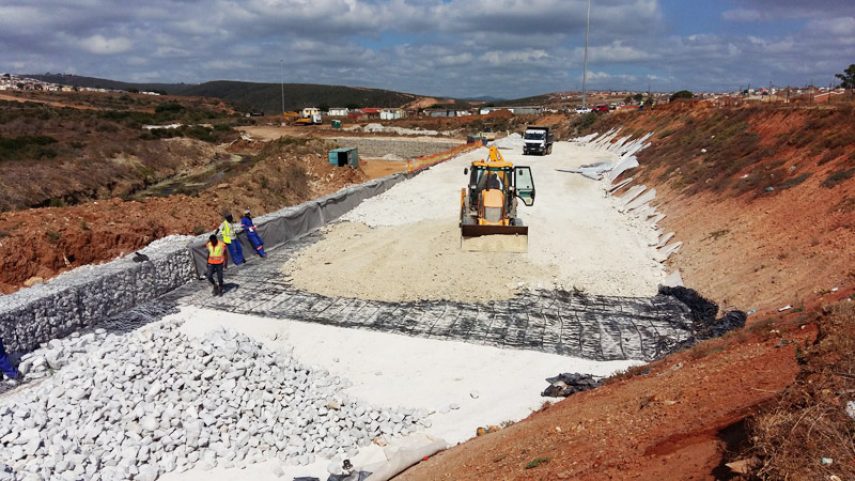THE technically-complex KwaNobuhle Area 11 Link Sewer project has made a substantial difference to the living conditions of people living on the outskirts of Uitenhage, Eastern Cape.
That’s according to JG Afrika, the firm of consulting engineers appointed by the Nelson Mandela Bay Municipality (NMBM) to provide civil engineering consulting services, including design, contract administration and site supervision, for the project.
Completed in 2016, it supplements the capacity of an existing sewer pipeline that had reached its full capacity and could no long cater to the increase in sewerage from rapidly-expanding housing developments in-and-around KwaNobuhle.
Velisani Nyoka, a JG Afrika technologist who worked on the project, said that the sewer pipeline discharges to the KwaNobuhle Wastewater Treatment Works (KWWTW), located north-east of this large township.
“The pipeline is approximately seven kilometres in length and comprises mainly un-plasticised polyvinyl chloride (uPVC) Class 34 heavy-duty pipe sections. They vary between 250mm and 500mm in diameter and were manufactured according to South African National Standards (SANS) 791 standards.
“Meanwhile, high-density polyethylene (HDPE) plastic pipe was installed at the road crossings using pipe-jacking technology to minimise the impact of construction activities in built-up areas. Ductile pipes were used to cross a valley, with this 50m-long section of the pipeline installed on top of four 600mm x 400mm concrete columns,” Nyoka said.
One of the challenges in construction the pipeline was the varying gradients of the terrain through which the pipeline traverses. They ranged from 0,25% to two percent in the flat areas and between two percent and 12% in the steep regions. It was, therefore, impossible to use deep excavations in the very steep sections to prevent high velocities.
A notable feature of the project is the 8m-high and 250m-wide gabion/Terramesh retaining wall that was built along the severely eroded and unstable embankment between KwaNobuhle South and North.
This structure protects both the new and old pipelines that run along the river during heavy rains, while also successfully addressing previous environmental and public safety concerns.
Unsuitable material was cut back at an average length of eight metres from the face of the existing embankment. Using an excavator, about 7 300m3 of material was removed during this stage of the construction of the wall.
The 3m x 3m x 1m Terramesh baskets were then installed on a 100mm-thick 19mm stone foundation that was built along the embankment to create a robust wall. It features a step of about two metres in height and 0,5m sideways along the entire length of the face to the final level.
Nyoka said the Terramesh baskets were manufactured from heavy Class A galfan (zinc alloy ZN 96AL5) wire to SANS 675 and SANS 10244-1 standards.
“They were coated to SANS 1580 and EN 10245-5 standards using a 0,5 mm polyvinyl chloride (PVC) coating and woven into a double-twist hexagonal mesh type 80 in accordance with the SANS 1580 standard. More than 1 700m3 of stone was used to tightly pack the baskets, which have a two metre-long ‘tail’ protruding from the back end to further strengthen and stabilise them during settlements,” he said.
They were placed on geogrids that were spread throughout the area that received G7 material.
The geogrids were positioned at two-metre heights of the fill material, with the geotextile membrane placed underneath and at the back of the Terramesh boxes for filtration purposes and to prevent the loss of fines.
Macdrains were then installed along the full length of the embankment for drainage purposes.
Spread across the 70-degree-angled slope of the embankment, they separate the fill and in-situ material to enable seepage water to drain down to the 110mm-diameter perforated pipes.
The water is then drained out of the wall via transverse pipes that were installed at 50m intervals along the length of the face.
Security fence and guard rails were also installed in front of the wall as further protection measures to complete this component of the KwaNobuhle Area 11 Link Sewer project.
A total of 18 small, medium and micro enterprises (SMMEs) from various wards of the NMBM were also sub-contracted by the principal contractor to build the retaining wall.
Arrangement of the many work packages and management of the SMMEs was an extremely complex undertaking. A fulltime SMME construction manager was, therefore, appointed to assist in the management and training of these emerging contractors.
Working in built-up areas also provided its share of challenges during the construction of the pipeline with the principal contractor having to contend with many hidden services.
Nyoka said that, despite the challenges and technical complexity of the project, it was delivered according to standard, drawing and specification, a feat he attributed to outstanding participation of all members of the professional team.

